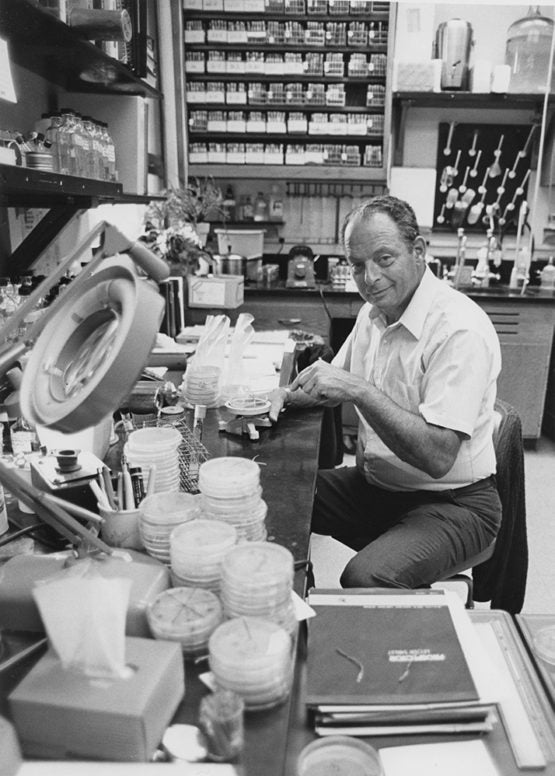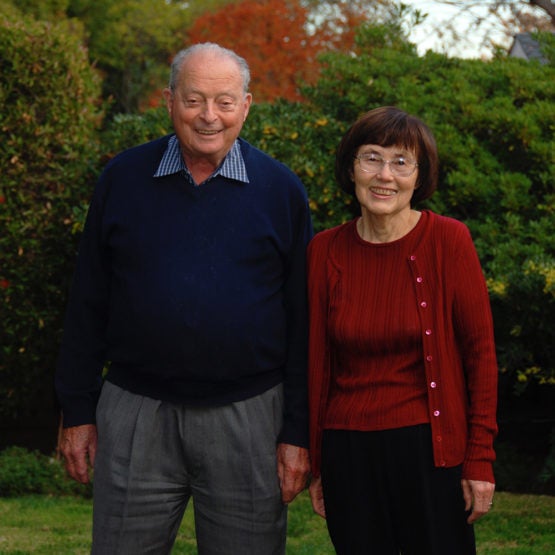Stanford geneticist Charles Yanofsky dies at 92
Throughout his more than half-a-century career, Charles “Charley” Yanofsky contributed to the fundamental understanding of genetics. Brilliant, humble and generous, he was a role model to students, friends and family.

Charley Yanofsky in his lab at Stanford in 1985. (Image credit: Chuck Painter)
Charles “Charley” Yanofsky, the Dr. Morris Herzstein Professor of Biology, Emeritus at Stanford University, was one of the world’s most influential geneticists. Put simply, everything scientists now know about genetics rests on his initial discoveries about the relationship between DNA and proteins. Remembered for his brilliance, generosity and love of sports, Yanofsky passed away March 16 at age 92.
“Charley was a dear friend and supportive colleague for me throughout my entire career at Stanford,” said Philip Hanawalt, professor emeritus of biology. “I marveled at his humble manner while he and his incredibly well-mentored students contributed world-class science for well over half-a-century.”
Yanofsky’s most famous and early contribution to the field of genetics, now known as the “central dogma” of molecular biology, confirmed that the linear sequence of amino acids in a protein corresponds to the linear sequence of chemicals that make up DNA.
“My father was one of the greatest scientists of the last century,” said Martin Yanofsky. “He was also a wonderful father and role model, not just to me and my two brothers, but to everyone who knew him.”
Foundational findings
Charley Yanofsky was born April 17, 1925, in New York. He attended the City College of New York but his undergraduate studies were interrupted by service in the Army in World War II, including active combat in the Battle of the Bulge. He later finished his bachelor’s in biochemistry and went on to Yale University in 1948, to earn masters’ and doctoral degrees in microbiology.
Yanofsky joined the faculty of Case Western Reserve University in 1954, which is where he first crossed paths with Paul Berg, who was a student there at the time.
“Since I was studying the same kinds of things that Charley was working on, I was well aware of his accomplishments, which I would say were profound, even at the earliest stage of his career,” said Berg, winner of the Nobel Prize in chemistry in 1980 and a professor emeritus of biochemistry at Stanford, who came to consider the Yanofskys like family. “He, to me, was a scientific idol.”
In 1958, Yanofsky joined the Stanford faculty as an associate professor of biological sciences, rapidly advancing to full professor in 1961.
At the time, many scientists favored the “one gene, one protein” hypothesis of former Stanford biologists George Beadle and Edward Tatum, which argued that each gene contains the code for a specific protein, but it was not yet proven.
Upon moving to Stanford, Yanofsky inherited Tatum’s lab and, in 1965, he and his colleagues published the paper confirming the relationship between genes and the proteins for which they code. Their experiments provided a detailed genetic map of mutations in a gene, showed how those mutations altered the amino acids in the corresponding protein and detailed how the map of the mutations corresponded to the map of the amino acid changes.
Following this triumph, Yanofsky continued to study the genes of the bacteria Escherichia coli and Bacillus subtilis, and a mold, Neurospora crassa, looking for basic information essential to understanding gene expression in all living things. His work led to the discovery of transcriptional attenuation – a process by which gene expression changes in response to subtle environmental clues – and revealed how changes in RNA structure allow RNA to serve as a regulatory molecule in bacterial and animal cells.
Fierce competitor, incisive mentor
Yanofsky and his family lived on the Stanford campus from the time he first joined the faculty. A devoted sports fan, he attended every Stanford basketball game and most football games for many years.
“On the tennis court, Charley was a fierce left-handed competitor,” said Marcus Feldman, a professor of biology at Stanford, who participated in weekly tennis matches with Yanofsky and Berg. “I and other players always enjoyed Charley’s good humor even in the ‘heat’ of competition.”
As a mentor and teacher, Yanofsky discouraged frills and gimmicks in papers and presentations – urging his students to focus on the real potential of their science. His generous guidance produced what Feldman characterized as a “large cadre of loyal and admiring followers.” Every Saturday, Yanofsky could be found at a local New York-style deli, welcoming his lab members to join him for lunch, recalled Donald Helinski, a former postdoctoral student in the Yanofsky lab.
“He was an outstanding mentor of young scientists, many of whom went on to distinguished careers in science,” said Helinski, who is a professor emeritus of biology at the University of California, San Diego.
Remembering his own time as a student in Yanofsky’s Gene Action course, Feldman said, “It was the first biology class that I had ever taken. To this day, I believe it to have been the best-taught class that I ever had in any subject.”
Paul Ehrlich, professor emeritus of biology, worked across disciplines with Yanofsky to bring molecular biology and population biology into the biology core curriculum. “Stanford is losing not just one of the all-time great scientists, but a wonderful man and a great friend,” Ehrlich said.
A full and accomplished life

Charley Yanofsky and his wife, Edna. (Image credit: Martin Yanofsky)
Yanofsky was a member of the American Academy of Arts and Sciences, the National Academy of Sciences and the Royal Society of London, and received the Albert Lasker Award in Basic Medical Research and the Genetics Society of America Medal, among many other awards. He was past president of the American Society of Biological Chemists and of the Genetics Society of America, and was a Career Investigator of the American Heart Association.
At age 79, Yanofsky was awarded the 2003 National Medal of Science. Of that honor, he said, “It’s always wonderful to be appreciated. It’s not what we do research for, but nevertheless, it’s nice when it happens, and everyone else can enjoy it, too – my friends, family and colleagues.”
Yanofsky is survived by his wife, Edna; his three sons, Stephen, Robert and Martin; seven grandchildren; and four great-grandchildren. His first wife, Carol, died of breast cancer in 1990. In lieu of flowers, please make contributions to the Charles Yanofsky Graduate Fellowship Fund.
